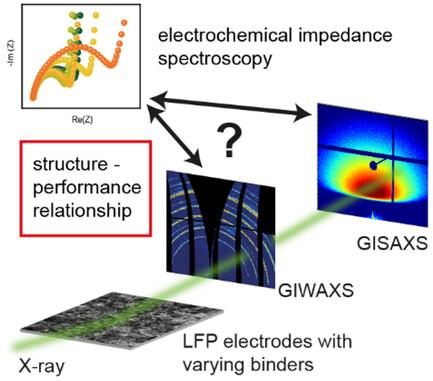电化学阻抗能谱和掠入射小角和广角 X 射线散射揭示的聚合物粘合剂成分对磷酸铁锂电极电荷转移电阻、形态和结晶度的影响
IF 11.1
Q1 MATERIALS SCIENCE, MULTIDISCIPLINARY
引用次数: 0
摘要
用于锂离子电池的电极材料通常通过 X 射线衍射 (XRD) 来研究其晶体结构。掠入射广角 X 射线散射 (GIWAXS) 是 X 射线衍射的延伸,因为平面内结构也可以获得。此外,利用掠入射小角 X 射线散射 (GISAXS),还可以揭示纳米级的形态信息。本研究通过 GISAXS 和 GIWAXS 对电池电极的纳米结构进行了研究,电池电极由活性材料磷酸铁锂(LiFePO4)、导电剂炭黑(CB)以及聚合物粘合剂聚偏氟乙烯(PVDF)和聚((三氟甲烷)磺酰亚胺锂苯乙烯)(PSTFSILi)组成。通过混合 PVDF 和 PSTFSILi 调整了粘合剂的化学性质。具体而言,研究了一系列以普通非导电 PVDF 和单离子导电 PSTFSILi 的不同重量比聚合物混合物为粘合剂的磷酸铁锂电池电极,以详细了解粘合剂对电极结构的影响。扫描电子显微镜 (SEM) 和电化学阻抗光谱 (EIS) 对这些研究进行了补充,以将形貌和结构与电化学行为联系起来。研究发现,无论粘合剂成分如何,磷酸铁锂晶粒相对于基底都不表现出任何优先取向,但其大小取决于粘合剂成分。本文章由计算机程序翻译,如有差异,请以英文原文为准。

Influence of the Polymer Binder Composition on the Charge Transfer Resistance, Morphology, and Crystallinity of LiFePO4 Electrodes Revealed by Electrochemical Impedance Spectroscopy and Grazing Incidence Small‐ and Wide‐Angle X‐ray Scattering
Electrode materials for application in lithium‐ion batteries are commonly probed by X‐ray diffraction (XRD) to investigate their crystalline structure. Grazing incidence wide‐angle X‐ray scattering (GIWAXS) is an extension to XRD since in‐plane structures are also accessible. Additionally, with grazing incidence small‐angle X‐ray scattering (GISAXS), morphological information on the nanoscale can be revealed. In this work, the nanostructure of battery electrodes, which consist of lithium iron phosphate (LiFePO4) as active material, carbon black (CB) as conducting agent, and the polymeric binders polyvinylidenefluoride (PVDF) and poly((trifluoromethane) sulfonimide lithium styrene) (PSTFSILi) is studied by performing GISAXS and GIWAXS. The chemical nature of the binder is tuned by blending PVDF and PSTFSILi. Specifically, a series of LiFePO4 electrodes with polymer blends of the common, non‐conducting PVDF and the single‐ion conducting PSTFSILi with different weight ratios as binders is investigated to understand the influence of the binder on the structure of the electrode in detail. Scanning electron microscopy (SEM) and electrochemical impedance spectroscopy (EIS) complement these studies to correlate the morphology and structure with the electrochemical behavior. It is found that LiFePO4 crystallites do not exhibit any preferred orientation with respect to the substrate, irrespective of the binder composition, but their size depends on the binder composition.
求助全文
通过发布文献求助,成功后即可免费获取论文全文。
去求助
来源期刊
CiteScore
14.00
自引率
2.40%
发文量
0
期刊介绍:
Small Science is a premium multidisciplinary open access journal dedicated to publishing impactful research from all areas of nanoscience and nanotechnology. It features interdisciplinary original research and focused review articles on relevant topics. The journal covers design, characterization, mechanism, technology, and application of micro-/nanoscale structures and systems in various fields including physics, chemistry, materials science, engineering, environmental science, life science, biology, and medicine. It welcomes innovative interdisciplinary research and its readership includes professionals from academia and industry in fields such as chemistry, physics, materials science, biology, engineering, and environmental and analytical science. Small Science is indexed and abstracted in CAS, DOAJ, Clarivate Analytics, ProQuest Central, Publicly Available Content Database, Science Database, SCOPUS, and Web of Science.

 求助内容:
求助内容: 应助结果提醒方式:
应助结果提醒方式:


